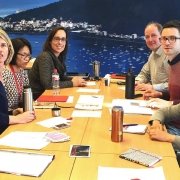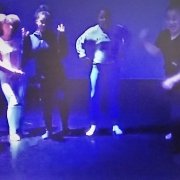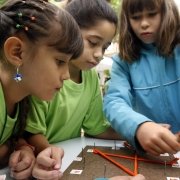Taalexpertisecentrum THUAS
Excerpt
Excerpt: The Language Expertise Center (LEC) is part of The Hague University of Applied Sciences and has existed for a long time, offering ‘on-demand’ language courses to students and employees. The founders state that a good command of (Dutch) language is an essential part of professional higher education. Students and employees need extra support (and sometimes encouragement) here.
The Language Expertise Center (LEC) survived several reorganizations at THUAS. Recently, the circumstances improved; more attention is given to increasing diversity, inclusive education and providing a safe learning environment for all students. In this context, the LEC has been reconsidering its role and position, researching the needs of students (and other community members). A Writing Center was founded in November 2016, which is the main focus of this project description. This Writing Center will ensure that traditional, centrally offered “fixed” (and sometimes target group related) courses will be complemented by tailor made one-to-one peer coaching, “on the job” and demand-driven courses.
Apart from that, teacher/team professionalization is also high on the priority list when it comes to the use of language in classrooms as well as curriculum development, course materials and assessments: internalizing and using didactics like Taalbewust Onderwijs (literally: “language-aware education”), which take the (diversity in) language command of the students into account. Language is everywhere, not only one of the subjects taught in class!
Another important activity is extra support for students who suffer from dyslexia, their learning environment, life style, etc.
In the near future, the LEC / Writing Center wants to offer support on English language development in addition to Dutch language support.
Narrative, origins and objectives of the initiative
What kind of project is this? Please give a short description (summary) of it.
The Language Expertise Center (LEC) is part of The Hague University of Applied Sciences and has existed for a long time, offering ‘on-demand’ language courses to students and employees. The founders state that a good command of (Dutch) language should be an essential part of professional higher education. Some students and employees need extra support in this regard. After all, it is a fact that language proficiency is one of the most important predictors of study success (and a fruitful professional career).
The LEC aims to operate in a an accessible, encouraging way and (implicitly) tries to help those with ‘underprivileged’ backgrounds: students of lower social economic status, with a migration or refugee background (sometimes Dutch not being their mother tongue), students with physical, psychological or intellectual disabilities (e.g. dyslexia), students with secondary vocational education (mbo) diplomas and many others. The staff does not always have the psychological or pedagogical expertise to coach or assist these students, and does not see it as their primary task, which is language support.
The Language Expertise Center (LEC) survived several reorganizations; periods in which language development was, consequently, not always high on the priority list at THUAS. Recently, the circumstances improved; more attention is currently given to increasing diversity (also in the needs of the students), inclusive education and a safe learning environment for all students. In this context, the LEC has been reconsidering its role and position, e.g. by researching the needs of students (and other community members) in relation to their own study programs. A Writing Center was founded in November 2016, similar to other university writing centers, especially Skills Lab at Utrecht University and ASN (‘Academic Writing Center’) at Nijmegen University ( https://www.ru.nl/asn/english/). Traditional, centrally offered “fixed” courses that made room for tailor-made one-to-one peer coaching “on the job” and demand-driven (sometimes target group-related) courses.
Apart from that, teacher/team professionalization is also high on the priority list when it comes to the use of language in class as well as curriculum development, course materials and assessments: internalizing and using didactics like Taalbewust Onderwijs (“language-aware education”) that takes the (diversity in) language command of the students into account. Language is everywhere, not merely a subject taught in class! Making remedial teaching possible is also one of the ambitions.
Another important activity is extra support for students who suffer from dyslexia, their learning environment, lifestyle etc.
In the near future, the Writing Center wants to offer support to English language development in addition to Dutch language support, in order to meet the ambitions THUAS has in the realm of internationalization.
Please tell us why, in general, this project is considered a successful one?
The Language Expertise Center has helped thousands of students. Up to recently, 2000-3000 students were helped by LEC annually, while the Writing Center also already helped hundreds of students since its establishment. Many attend the LEC/Writing Center for help, and the people working at the LEC office are always open to all kinds of questions, trying to help or give advice. Apart from that: the project always managed to survive, also in hard times, thanks to the motivation, persuasion and perseverance of its participants.
And why would you consider it a grass-roots initiative?
As mentioned earlier, the project started a long time ago, and has ever since been kept going by teachers and students. The Writing Center works with a buddy system (students with good language proficiency supporting their peers). This works very well and guarantees the accessibility of “tailor made” help.
What challenges needed to be solved in this project?
To support students with poor language proficiency that may be caused by many factors, giving them self-confidence and offering them a safe environment to learn and practice.
Is this initiative based on any particular theoretical framework? Which one?
In terms of teacher and team professionalization, a lot of inspiration was taken from research and practice by Artevelde Hogeschool (a university of applied sciences) in Ghent, Belgium. Dutch research was also a source: Elke Peters and Tine van Houtven (2010, 2013), Raad voor de Nederlandse Taal en Letteren (2014) and Nederlandse Taalunie (2013)[1] on language development in Higher Education. This has led to the idea of Taalontwikkelend Lesgeven (TOL), a didactical concept that connects language education and development with relevant professional practice and the jargon typically used there. The strategy is, in short, to make all students become familiar with this jargon as early (and integrally) as possible, by making a connection with their prerequisite knowledge and expand this by interaction / production of language in the classroom, and that this jargon is used consequently throughout the program, by every stakeholder.
TOL has been successfully applied at Arteveldehogeschool Belgium; for information and instruction movies (in Dutch), see: https://www.arteveldehogeschool.be/dienstverlening/diensten-voor-scholen/taalontwikkelend-lesgeven/taalontwikkelend-lesgeven-het-hoger
https://www.taalbeleidhogeronderwijs.org/wp-content/uploads/2015/03/LEIDRAAD_TOL2_GVD.pdf
[1] In English: both organizations mentioned here are part of the Dutch Language Union; English website: https://over.taalunie.org/dutch-language-union).
(Appendix) Is your intervention standing on its own or is it a part of a bigger and more holistic approach?
In the past, is was mainly standing on its own; in the future it aims to be part of and at the heart of THUAS policy.
Please describe the group(s) intended as beneficiaries of this initiative
Why has this group (have these groups) been chosen?
On the one hand, no specific target group is addressed; the LEC wants to help every student, especially those of ‘underprivileged’ backgrounds, like first generation students and/or those of lower social economic status families, with migration and/or refugee backgrounds (often Dutch not being their mother tongue), students with physical or psychological disabilities (e.g. dyslexia), students with secondary vocational education (‘mbo’) backgrounds, and many others. These students statistically tend to underperform and also show, on average, poorer language skills.
On the other hand, one particular group that gets special attention are the Caribbean students (mainly from Dutch Antilles, due to The Netherlands’ colonial past). Those coming from the tropical Dutch islands overseas (“CAMBES”[1]) are part of the Kingdom, but don’t speak or write Dutch as their first language; in fact, it is only their fourth language, after Papiamento, Spanish and English). Apart from that, when coming overseas to study, they leave behind their families and sometimes experience culture shock, performance-related pressure and feelings of being homesick. For these students an language week is organized annually - right before the start of the academic year. Topics are reading, listening, conversation and writing, but also excursions, workshops and attention to personal development, etc. It is considered important to immerse the students in Dutch language, culture and manners, thus creating awareness about what has to be done to succeed in the first year at THUAS.
[1] Curacao, Aruba, st Maarten, Bonaire, st Eustasius and Saba.
Could you please tell us something about the relative size of the (of each) target group, within the school/university population, region and/or country?
Being a highly diverse university (student) community in a “superdiverse” and international city, many students (50% or more) could be considered as part of the multidimensional target group. Apart from that, students suffering from dyslexia are identified as a specific target group. This group may be much bigger than one would expect: in the Netherlands, about 8% of the 7-11-year-old children is, according to their parents, suffering from some form of dyslexia (CBS, 2015: https://www.cbs.nl/en-gb/news/2016/40/slightly-more-children-diagnosed-with-dyslexia).
About the target group coming from the Antilles: about 200 students come to THUAS annually, 25-50% of them following the aforementioned language week in summer.
Which social characteristics are taken into account and what is the geographical area covered?
Social characteristics as described above; geographical area is The Hague area, The Netherlands.
On which level is the project implemented?
On THUAS-level
Please describe the political and socio-economic factors that you believe have been important enablers for your initiative
Did the initiative have political support?
The Dutch government (Ministry of Education, Culture and Science) encourages more diversity in HE, and stimulates the universities (especially in the big cities) to encourage emancipation and empowerment of underrepresented groups (with stipendiums, annual reports, etc.). In regional policies (e.g. Rotterdam, The Hague metropolitan Area), there is even worse sense of urgency because the urban population here is super diverse. Educational organizations are stimulated to cooperate in order to create pathways for students from underrepresented groups. The municipality of The Hague, for example, participates in projects to create a more inclusive local society and education.
How did it fit with local, regional or national policies?
See question above. The same answer applies here. The municipality of The Hague wants to pay extra attention to the different pathways to higher education and wants to encourage educational organizations to make their programs as accessible as possible.
Who are the stakeholders supporting the initiative?
The Board, the dean of M&O, 10-25 freelance teachers (up to recently; in this period of recalibration, only 3 freelance teachers are working) , 4-5 peer coaches.
Are there particular demographic changes present that are influencing the project?
No, apart from the student population gradually getting more diverse every year.
What is the institutional strategy and culture of the (educational) organization?
As already stated, The Hague University of Applied Sciences (THUAS) wants to be an inclusive, international and highly diverse university community. A community in which respect for different backgrounds and world views are core values. THUAS wants to change (slogan: “Let’s Change. You. Us. The world.”)
To what extent does the initiative have an influence on institutional policy (or potential influence) of the (educational) organization?
Now that the THUAS organization is, after turbulent times, sailing into calmer waters, more attention is given to language education and language development. The time seems to have come to give a real boost to activities and policy-making in this area.
(Appendix) Is there public support for your initiative and the issue it addresses?
(Appendix) What other factors do you think have been important for the success of this initiative?
Please describe the overall initiative design and the methods and tools used to reach the goals
Please describe the specific activities carried out.
Activities at LEC have always been very “hands-on” and informal, providing solutions to practical questions and problems.
Recently, this process is under review. The ambition is to create a more remediating program instead of being mainly directed towards already existing curricula. Teacher and team professionalization (applying TOL) will be an important part of the activities. The Writing Center will continue helping those who need it (with or without a buddy). Besides that, dyslexia classes and the Language Week will remain in place, while English language support will be added to the assortment.
The Writing Center works as follows: Traditionally, students and teachers can register by visiting the office or the website. They are asked to fill in a survey to determine their needs and to specify their questions, which are matched with the courses TEC offers. Besides that, it also happens that people just come by and ask their questions on a more ad hoc basis.
What were the key roles (teacher, student, management team etc.) within the project?
The coordinators of the project, the freelance teachers participating (LEC) and (writing) tutors (Writing Center).
What ideas, tools, theories, models, methodology (etc.) have been used to reach the goals?
TOL, buddy system. As stated before, policy-making and renewing the project is currently under construction.
What are the final revenues of the project?
Please describe if your project ensured its sustainability
If so, how did you ensure the short-term impact of the project?
As described, the project and its predecessors have existed for many years (since about 2000). As for the new developments, evaluations (with students with dyslexia, Caribbean students and others) show that many feel that the LEC has helped them. For the Language Week: this exists for ten years now and early research already showed that the students who participated have higher “first year survival rates” and better results in general than the ones that didn’t participate. As for the new Writing Center: the short- and long-term impact will be monitored more systematically and the goals will be formulated more precisely.
And how did you ensure the long-term impact of the project?
New developments, current research and a new language policy (revision of the old one from 2011) must lead to a new strategic vision on language development and language goals.
Has your project been replicated elsewhere?
The idea of academic Writing Centers comes from the US, and is gaining ground in The Netherlands recently.
Please tell us about the resources used in this initiative
What was the budget for the initiative?
In the past, the LEC has been more or less financially independent by charging its activities on the concerning faculties. Apart from that, an annual subsidy of 200.000 Euro’s is granted to the LEC by the board. Recently, an amount of 150.000 Euros was requested for (to the THUAS Innovation Fund) to develop pilots.
How much did the initiative depend on volunteers?
How were the costs perceived by the public/the sector/other stakeholders?
To what extent did the initiative achieve its objectives?
Please describe the evidence to support the success of your initiative.
Evaluation and monitoring did not go very well in the past; language lessons that were offered were good (and showed sufficient satisfaction rates), but their actual impact was not very clear. In this way, language is not integrated in the rest of the curriculum and is, therefore, seen as an (increased) burden by many. In the near future, the Writing Center aims to operate more at the heart of the programs. Implicitly, all programs seem to presuppose a (Dutch) language command at B2 level. However, 50-80% of the students do not reach this level. This seems partly due to transfer problems (not being able or prepared to apply ‘language lessons learned’ in secondary school or earlier courses to other subjects and assignments in the curriculum) and probably also due to their attitude towards use of language. This problem will be addressed in the future!
Did the intervention lead to any unintended (positive) outcomes?
Increased self-confidence, sense of belonging in some students (reported) while their primary goal was “only” to improve their language skills.
What indicators (quantitative and qualitative) have you measured to demonstrate success?
See above: this did not go so well in the past and will be done in a more goal-oriented and systematic way in the near future.






 Robinson Henao
Robinson Henao

 (C)E-Fabrik • G.de CROP
(C)E-Fabrik • G.de CROP